We celebrated our 50th birthdays with a memorable trip to Santorini. We hiked volcanic craters, swam in the Aegean, and enjoyed Greek cuisine. Santorini’s stunning views, rich history, and charming villages made it the perfect setting for this special adventure.
Turning 50 is a milestone in anyone’s life, and for me, it called for an adventure with friends who share not only my age but my passion for celebrating life. With four of my best friends from France—each marking their own half-century this year—we set our sights on a place that matched the significance of the occasion: Santorini, Greece. Known for its iconic whitewashed villages, blue-domed churches, and vibrant sunsets over the Aegean Sea, Santorini is a paradise steeped in natural beauty and layered with centuries of history.
Our base was a cozy hotel in Perissa, a town on the southeastern side of the island famous for its unique black volcanic sand beach—one of the few beaches on Santorini where you can relax right by the sea. The adventure began with three of us flying directly from Paris Orly to Santorini. As our pre-booked taxi wound through Santorini’s rugged, volcanic landscape at sunset, it was clear this trip was going to be unforgettable.

After settling into our hotel, we took a stroll to the beach and began exploring Perissa’s charming beachfront restaurants. Our first dinner was a typical Greek meal of feta salad, fresh bread, and a refreshing drink of ouzo, Greece’s iconic anise-flavored spirit. The sound of waves on the black sands set a serene tone, while a friendly stray cat kept us company, a staple of Greek island life.

The next day, we embraced relaxation and enjoyed each other’s presence. We spent time by the pool that was literally steps from our door, before heading out for groceries and preparing for the arrival of our other two friends. Again a cat was observing us checking if we had something to offer.

Once the gang was all together we cheered to our reunion and went for a stroll around Perissa.

Our next day flowed with ease, filled with laughter, delicious meals, and exploration. Ultimately we ended the day by watching France play Spain in the Euro Cup at a nearby café. The Spaniards crowd added to the lively atmosphere, even though France ultimately lost. Over dinner, we immersed ourselves in Greek cuisine, sampling stuffed vine leaves, fried saganaki cheese, and more feta and ouzo as we toasted to old friendships.

One of our outings was a boat trip to explore the caldera, an experience that brought Santorini’s ancient history alive. The caldera’s violent formation is the origin of many legends, including the possible source of Plato’s Atlantis. Santorini, known in ancient times as Thera, is part of a volcanic archipelago formed by massive eruptions around 3,600 years ago. That eruption, one of the largest in human history, likely triggered the collapse of the Minoan civilization on nearby Crete. The volcanic activity left behind the caldera, a water-filled crater now central to the island’s dramatic beauty.
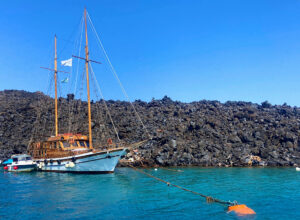
Our first stop was Nea Kameni, an uninhabited volcanic island. Here, we hiked up rocky paths to look down into craters that still release plumes of warm steam—a visible reminder of the volcanic forces that shaped the island.

After hiking, we visited the hot springs at Palaia Kameni. While some tourists eagerly jumped and swam into the warm, iron-rich waters, I opted for a refreshing swim in the cooler, surrounding sea. We continued on to the island of Therasia, which offered a quieter, traditional Greek vibe. Therasia once was part of the larger Santorini before the island’s volcanic eruptions reshaped it. Rather than hiking up the steep hills in the midday sun, we enjoyed a leisurely lunch by the water, surrounded by the ever-present cats of the Cyclades.


The boat took us for a nice ride along the foothills of Oia and Fira and by the chapel of the Seven Children, a small cave-like structure only accessible by boat. Legend holds that seven youths hid there from Roman persecution, only to be walled off and later canonized once Christianity spread. Gazing out at this hidden chapel, we felt the power of the legends that have kept Santorini’s history alive for centuries.

Back on Santorini, we attended a “traditional” Greek night at a local taverna. Though it was clearly a bit staged for tourists—with enthusiastic plate-smashing and energetic dancing—it was a chance to embrace the vibrant spirit of Greek culture with laughter and abandon.
The next day, we rented a car and explored Santorini. We explored Oia, a village famous for its whitewashed houses, winding stairways, the narrow and cobbled streets and domed churches as well as for its scenic views and stunning architecture.




To escape the crowds, we ventured into Finikia, a quiet traditional village where we wandered aimlessly, savoring the charm of its hidden alleys, tucked away from the bustling tourist trails. This quiet hamlet was filled with narrow, winding streets, where the Cycladic architecture seemed untouched by the passage of time.

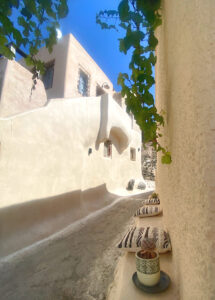
The next day, we set out for Fira, the heart of Santorini, where we enjoyed a delicious lunch perched high on the cliffs, gazing out over the deep blue waters of the caldera. The view was mesmerizing, knowing that beneath us lay the remnants of one of the most powerful volcanic eruptions in history, which around 1600 BCE shaped the island into what we see today.
Afterward, we strolled through the charming cobblestone streets, stopping by quaint shops and finally deciding to all get matching dresses—a nod to the flowing, goddess-like styles inspired by ancient Greece.





Together, we made our way to the famous Black Sand Beach, its sand formed from volcanic rock as a legacy of Santorini’s turbulent geological past. We took a little hike to a quiet spot, lay down, and simply listened to the waves crashing, eagerly waiting for the sunset.
As the sky turned to soft shades of orange and pink, I went for a walk along the beach and discovered some beautifully decorated rocks—little treasures that felt like the island’s silent art.


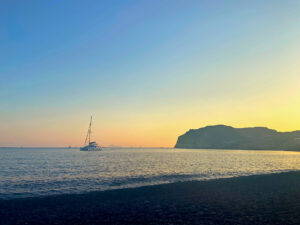
After sunset, we drove back to Perissa for dinner and ended the night with our own “fashion walk” in our Greek goddess dresses. The laughter and giggles were endless. But there was a bittersweet touch, as it was the last night for one of our friends.
The next day, after waving goodbye to one of us, one of our last excursions was a visit to Kamari and the nearby cliffs of Ancient Thera. The remains of Ancient Thera date back to the 9th century BCE and were later settled by the Romans, leaving traces of temples, markets, and communal baths. The boat ride was very bumpy but still very amazing to see those crystal blue waters. Though the entrance fee was steep, we opted instead to relax at a beachside taverna and enjoy the view.
The next day we said our goodbyes to two other friends as we splurged on a stay at a luxurious hotel perched on the caldera rim in Fira. The view was like something out of a dream: endless blue seas framed by jagged volcanic cliffs. We enjoyed and relaxed by the pool and did some final shopping. Our final dinner had us gazing out at the caldera, soaking in a moment that felt like pure magic.



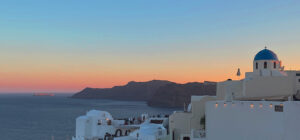
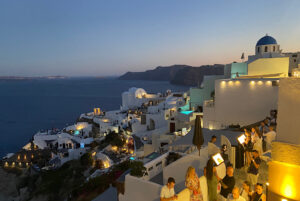

The next morning, as we boarded our flight back and said goodbye to Santorini, we looked down over the Aegean and the island’s dramatic cliffs. This wasn’t just a trip; it was an experience woven with deep friendship, laughter, and a tangible connection to history.

Santorini gave us much more than just a scenic backdrop for our reunion. It gifted us a rare connection with history—from the ancient mysteries of the caldera to the myths surrounding its picturesque chapels, each view seemed to tell a story. As we boarded our flight back, glancing down at the Aegean islands bathed in sunlight, we knew we’d just shared a once-in-a-lifetime journey that would linger in our memories forever. Here’s to deep friendship, to Santorini, and to many more adventures. Next stop: the Paris 2024 Olympics!

One of the best resources I’ve come across.
Very useful and well-written.